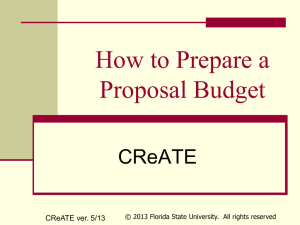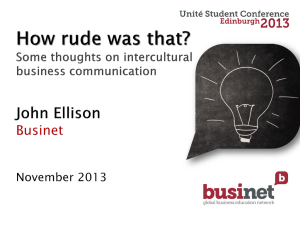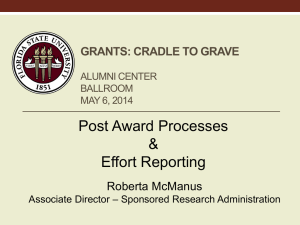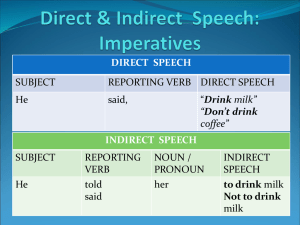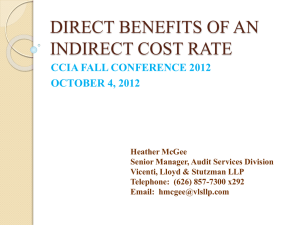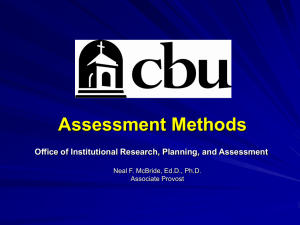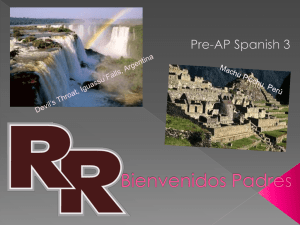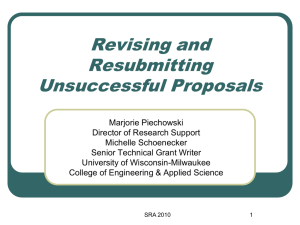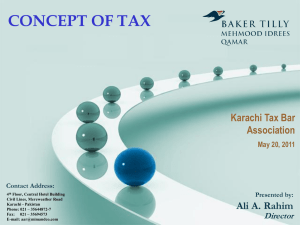Office of Proposal Development
advertisement
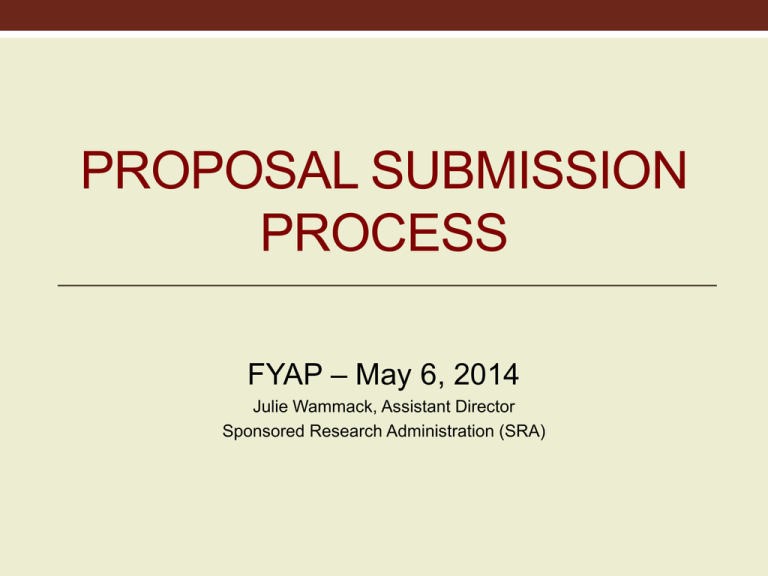
PROPOSAL SUBMISSION PROPOSAL SUBMISSION PROCESS FYAP – May 6, 2014 Julie Wammack, Assistant Director Sponsored Research Administration (SRA) 2 Steps for Proposal Submission • • • • • Find funding that matches your research interests/needs Review all the agency documents – funding solicitation, agency guidelines, etc. Prepare proposal Obtain institutional approvals Submit the proposal to Sponsored Research Administration (SRA) Proposal Tools • Staff Assignment Sheet • Facts Sheet • Transmittal Form/Instructions • Program Announcement/Solicitation • Application package • Agency Guidelines 4 Contact Sponsored Research Administration (SRA) – ASAP • Establish a working relationship with the administrator who will process your proposal • Administrator provides agency-specific expertise • Questions about the proposal process can be answered • 3-day submission policy • Documents needed for SRA • PI Responsibilities/SRA Responsibilities Three-Working-Day Policy • SRA Administrator needs at least three working days prior to the proposal deadline to review the proposal for compliance • This allows for feedback and suggestions to keep the proposal compliant with the agency guidelines and FSU policies • By 9am of three-day deadline, SRA Administrator must receive “complete proposal” • PI can work on narrative/scope of work until 9am of the deadline day Three-working-day Deadline Chart Sponsor Deadline Monday Tuesday Wednesday Thursday Friday Saturday (if no agency guidance, Friday is considered deadline) Sunday (if no agency guidance, Friday is considered deadline) SRA Internal Deadline Previous Wednesday by 9 am Previous Thursday by 9 am Previous Friday by 9 am Monday of the same week by 9 am Tuesday of the same week by 9 am Tuesday of the same week by 9 am Tuesday of the same week by 9 am 7 Review ALL Proposal Documents • Funding Announcement: Request for Proposal (RFP), Program Solicitation, Request for Application (RFA), Broad Agency Announcement (BAA) • Application Instructions • Agency Guidelines • All these documents provide information pertinent to your proposal • The instructions/guidelines must be followed or you risk the proposal being ‘returned without review’ for non-compliance. 8 Request for Proposal (RFP) • Program Description • Eligibility (Limited Submission?) • Funding Limits • Deadlines – Due Dates for Submissions • Submission process – electronic? Hard copy? • Review/Evaluation Criteria • Award Description • Award Administration • Reporting requirements, etc. NEH – Challenge Grant Deadline: May 1, 2014 Program Description: • NEH challenge grants are capacity-building grants, intended to help institutions and organizations secure long-term support for their humanities programs and resources. Expenditures not eligible for support: • recovery of indirect costs Type of award: • Matching grant - Recipients must raise three times the amount of federal funds offered, . . . Eligibility: • Institutions may apply for only one NEH challenge grant in a calendar year 10 Basic Proposal Documents • Transmittal Form • Scope of Work • Budget • Budget Justification • plus • All other agency-required documents NOTE: Proposal must be submitted to SRA in ready-form for submission 11 Transmittal Form – Institution Approvals • Agency and funding announcement • Proposal due date and submission type • Name of PI/Co-PIs, other personnel and departments • • • • involved Amount requested and project performance period Distribution of the indirect costs between the participating departments Special commitments PI, Co-PIs, Chair & Dean approvals of proposal Electronic Transmittal - OMNI • To submit a proposal through OMNI - use the proposal • • • • • guide http://www.research.fsu.edu/contractsgrants/documents/pro posaldevelopmentguide.pdf Any employee may create a proposal/submit it for approval Employees entered on the Proposal Resources page or added by the workflow program can view the proposal Once the proposal data has been entered and attachments uploaded, ‘Start Approval Process’ After this step, the proposal is frozen and may not be edited by anyone unless denied & returned back to the originator or after the SRA office has approved and submitted 13 Scope of Work • May be referred to as project narrative, project description, or technical portion • This is the most important part of the proposal and should be the reason why the project is or is not funded • The agency outlines the requirements or sections that should be included Additional Documents Other Items that may be required: • Requests for internal approvals (i.e., cost sharing commitment form) with appropriate departmental, chair, and dean approvals • Commitment letters from entities with whom you wish to subcontract • Forms and/or application required by the sponsor • References, biosketches, current/pending support, etc. 15 Prepare the Proposal Application • Download the application forms from the agency website or upload the proposal documents for grants.gov, FastLane or other sponsor-specific electronic submission systems • Complete forms in the application and attach required items • Most proposals include the following: • Abstract, Project Narrative, Budget, Budget Narrative, Biosketch, Current/Pending Support, References, Facilities/Equipment Statement 16 Standard NSF Grant Application • Project Summary – 1 page • Project Description (narrative) – 15 pages • Budget/Justification (3 pages) • References • Biosketches – 2 pages – specific format • Current/Pending Support • Facilities/Equipment • Data Management Plan • Postdoc mentoring plan if requesting support for a postdoc 17 Budget Development • Direct Cost Categories • Facilities &Administrative (F&A) Costs or Indirect Costs or “overhead” 18 Direct Costs – A-21 • Direct costs are those costs that can be identified specifically with a particular sponsored project, an instructional activity, or any other institutional activity, or that can be directly assigned to such activities relatively easily with a high degree of accuracy. 19 Indirect Costs - F&A - Overhead • Costs incurred for common or joint objectives and, therefore, cannot be identified readily and specifically with a particular sponsored project, an instructional activity, or any other institutional activity. 20 FSU’s Indirect Cost Rates • FSU has a negotiated indirect cost rate with the Dept of Health and Human Services (DHHS) • Indirect Cost Rates are applied depending on the following: • Type of Agency • Location of Project (on/off campus/Mag Lab) • Type of Project • Solicitation Recovery of Indirect Costs • FSU’s policy is to recover the full indirect costs based • • • • on our negotiated rate agreement Most Federal agencies allow our full indirect cost rate and consider a reduced rate as cost-sharing NSF prohibits cost-sharing and other Federal agencies are following their lead There is no need for a waiver/reduction of indirect costs if the agency has a limit/restriction on indirect cost recovery A request for reduction of the indirect cost rate must be approved by the VPR before the proposal is submitted 22 Indirect Cost Base - MTDC • Modified Total Direct Costs (MTDC) consists of all salaries and wages, fringe benefits, materials, supplies, services, travel, and subgrants/subcontracts up to the first $25,000 of each subgrant/subcontract • MTDC excludes equipment, capital expenditures, charges for patient care, tuition remission, rental costs of off-site facilities, scholarships, fellowships, and the portion of each subgrant/subcontract in excess of $25,000 • Typically applied to Federally-funded projects 23 Indirect Cost Base - TDC • Total Direct Costs (TDC) – consists of all direct costs • FSU policy - exclude matriculation from indirect cost base • Typically applied to non-federally funded projects 24 Sample Budget Salaries/Fringe Equipment Supplies Publications Tuition Total Direct MTDC/TD Base Indirect Costs Total Requested MTD $50,000 $10,000 $ 3,000 $ 2,000 $11,712 $76,712 $55,000 $28,600 $105,312 TD $50,000 $10,000 $ 3,000 $ 2,000 $11,712 $76,712 $65,000 $ 6,500 $83,212 25 Personnel – Salaries/Wages • Include faculty, technicians, post-docs, graduate students, & other personnel needed to accomplish the project objectives NOTE: for Federally-funded projects, administrative & clerical personnel normally fall within the indirect costs category and cannot be charged as “direct costs” 26 Fringe Benefits • Faculty/A&P/USPS • Retirement; Health Insurance; Social Security & Medicare • Worker’s Comp & Unemployment • OPS Students* • Worker’s Comp & Unemployment • Grad students supplement for health insurance • OPS Non-students • Medicare; Worker’s Comp & Unemployment • Health Insurance for all OPS employees working 30+ hours/week • Terminal Leave Pool Health Insurance – • 12 month employees – proportionate to salary request • For all OPS employees working 30+ hours/week 27 Consultants • Outside individuals with expertise and skills that will add value to project • Costs are usually listed in terms of daily rate • Consultants are typically paid in the form of a subcontract • Consultants are never listed in the salaries & wages section and faculty & other FSU staff should not be listed as consultants Equipment • Items costing $5,000 or more with a useful life of 1 year or more • Items costing below $5,000 are considered materials/supplies and should be identified on that line • Equipment should be detailed in the budget justification • Equipment requests should only include those items needed to complete the project • FSU has a policy for purchasing IT Devices on Federally- funded projects 29 Supplies Supplies and materials related to the project • Can be listed in budget as broad categories such as glassware, chemicals or art supplies • Minor equipment costing < $5,000 NOTE: For Federally-funded projects, routine office supplies are normally treated as an indirect costs (paper, pencils, post-it notes, etc.) 30 C.A.S. Exemptions • In exceptional circumstances, indirect costs may be charged ‘directly’ to a sponsored project. • Exceptional circumstances means that the project requires an extensive amount of administrative and/or clerical support or goods/services significantly greater than the routine level provided by an academic department • A C.A.S. exemption is REQUIRED to direct charge administrative and clerical salaries and other administrative-type expenses • In addition to meeting definition of exceptional circumstances, costs must be specifically identifiable to a particular sponsored project, be reasonable, allowable and allocable. 31 Travel • Project-related travel is usually allowed and may include trips to collect data, present findings at a professional meeting, meetings with program officers or collaborators, etc. • Reimbursement of costs should be consistent with FSU’s travel policy • Most agencies (and SRA) require a break-down of funds requested, such as airfare, hotels, car rental, etc. 32 Subawards/Subcontracts • Represents a collaboration of work by one or more other institutions • Costs for subawardee is presented in a separate line item and should include both the subawardee’s direct and F&A costs • A subaward detailed budget should be included as part of budget justification • Subawardee’s F&A costs are calculated in accordance with the subawardee’s negotiated F&A rate agreement 33 Subawards / Subcontracts If a collaboration is proposed, each collaborator needs to provide: • Letter of commitment from the Sponsored Program Office (not PI) • Scope of work for the PI’s activities • Budget • Budget Justification • Other agency required documents 34 Other Direct Costs • This category contains all other proposal costs, i.e., animal per diems, publication charges, graphic fees, matriculation, communications, shipping, etc. NOTE: Postage, local telephone, and memberships are normally treated as F&A costs on Federally-funded projects. 35 Matriculation • Matriculation costs (minimum of 9 hrs) should be included for graduate assistants supported by the project • Graduate Matriculation Rate for 14-15 is $433.77/hr or $11,712 for 27 hours (in-state) • If matriculation costs are not included in budget, an alternate source for paying must be identified (waiver 2 or 3 on transmittal form) • FSU excludes matriculation from F&A calculations in all proposals 36 Matriculation • Multiyear proposals should include a 7.5% increase in matriculation costs annually • Out of state matriculation is not an allowable cost in most circumstances • College of Engineering may apply out of state rates to their proposals • Certain training grants allow out of state matriculation. Check the sponsor guidelines • Fees are not an allowable cost unless applying for a training grant 37 Cost Sharing • Costing sharing or matching is that portion of project costs not borne by the sponsor. • A cost sharing commitment means any cost sharing included and quantified (e.g., % of effort and/or dollar amount) in the proposal budget, proposal narrative or award document. The award document may incorporate the commitment directly or by reference to the proposal. • Project enhancement means describing "resources that are available" for the project but are not quantified in the proposal budget, narrative or other documents. This is not considered a cost sharing commitment. 38 FSU Cost Sharing Policy • FSU’s policy is to make a cost sharing commitment only when required by the sponsor or by the competitive nature of the award and then only to the extent necessary to meet the specific requirements of the sponsored project. • If a PI requests an exception to this policy, the department Chair and Dean must approve. • The VPR approval is required, also. • Cost sharing should be approved well before the proposal deadline SRA Review - Provide Feedback • Review of Program Solicitation; Agency Guidelines • Review of Transmittal Form - hardcopy or in OMNI • Review Budget/Justification • Salaries – actual salary; escalation if included should be reasonable and disclosed • Indirect Cost Rate/Calculation • Allowable Costs • Scope of Work • Other Documents • Agency required documents – biosketch/currentpending support, etc. • Internal Approvals: • Cost Sharing Commitment/CAS Exemption Request Types of Submission • Electronic – Federal Agencies • (Grants.gov, FastLane, NSPIRES, etc.) • PI/Dept is responsible for completing application • SRA submits • Email – State Agencies, Institutions of Higher Education • PI can email directly after SRA approves proposal • Hardcopy • PI/Department is responsible for making copies and delivery after SRA approves proposal 41 Questions? Sponsored Research Administration 850-644-5260 srs@mailer.fsu.edu
